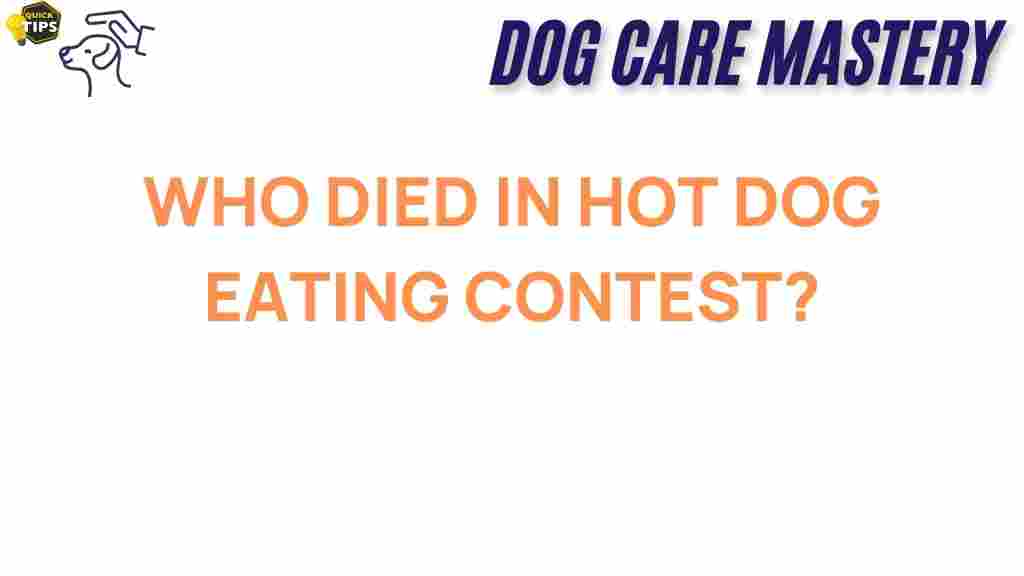The Shocking Truth Behind Fatalities in Hot Dog Eating Contests
Hot dog eating contests are a staple of American culture, often celebrated at summer festivals, sporting events, and even television broadcasts. These contests attract thousands of spectators, all eager to witness competitors push the limits of human capacity while devouring as many hot dogs as possible in a fixed amount of time. However, beneath the surface of this seemingly light-hearted competition lies a darker reality that few consider: the risks associated with extreme eating challenges. In this article, we will dive deep into the shocking truth behind fatalities in hot dog eating contests, exploring the dangers, the science behind competitive eating, and tips for those who dare to participate.
Understanding Competitive Eating
Competitive eating is not just about shoveling food down one’s throat; it involves a range of techniques and strategies. Contestants often train extensively to improve their eating speed and capacity. The goal is to consume as much food as possible within a set timeframe, typically ten minutes for hot dog eating contests. But what does this training entail?
- Stretching the Stomach: Many competitors practice by consuming large volumes of water or low-calorie foods to stretch their stomachs.
- Swallowing Techniques: Competitors learn to take large bites and swallow quickly to minimize chewing time.
- Breath Control: Effective breath control is essential, allowing contestants to eat more efficiently without risking choking.
The Dangers of Hot Dog Eating Contests
While competitive eating can seem harmless, the dangers are very real. The most alarming risks include:
- Choking: The primary concern in hot dog eating contests is choking. Hot dogs are slippery and can easily block the airway if not chewed properly.
- Gastric Rupture: Overeating can lead to gastric rupture, a life-threatening condition where the stomach tears from excessive pressure.
- Asphyxiation: In extreme cases, inhaling food during the eating process can lead to asphyxiation.
The Science Behind Eating Contests
To understand the risks, it’s crucial to examine the physiological effects of consuming large quantities of food in a short time. When a person eats, the body sends signals to the brain indicating fullness. However, competitive eaters train themselves to ignore these signals, which can lead to severe consequences.
Here are some key physiological factors at play:
- Stomach Capacity: An average stomach can hold about 1 to 1.5 liters of food. Competitive eaters often train to expand this capacity significantly.
- Hydration Levels: Many competitors consume water or other liquids to aid swallowing and expand stomach capacity, increasing the risk of water intoxication.
- Risks of Overeating: Overeating can trigger the body’s stress response, leading to increased heart rate and blood pressure.
The Fatal Incidents
The most shocking aspect of hot dog eating contests is the fatalities that have occurred over the years. While these incidents are rare, they highlight the extreme risks associated with the sport.
For instance, in 2007, a contestant tragically passed away after participating in a hot dog eating contest. The cause was later determined to be asphyxiation. Such incidents serve as a grim reminder of the potential consequences of competitive eating.
How to Partake Safely in Hot Dog Eating Contests
If you are considering participating in a hot dog eating contest, it’s crucial to take safety precautions. Here’s a step-by-step guide to minimize risks:
Step 1: Preparation
- Consult a healthcare professional to evaluate your health and fitness levels.
- Participate in training sessions to build your eating capacity gradually.
- Practice swallowing techniques with smaller food items before attempting hot dogs.
Step 2: During the Contest
- Avoid eating alone; always have a spotter present who knows how to perform the Heimlich maneuver.
- Stay hydrated, but avoid excessive liquid intake immediately before the contest.
- Take smaller bites, as this can help prevent choking.
Step 3: Post-Contest Care
- Allow your body to rest and recover after the contest. Avoid eating large meals immediately afterward.
- Monitor your health for any unusual symptoms, such as severe pain or difficulty breathing.
Troubleshooting Tips for Contestants
Even with precautions, issues may arise during a hot dog eating contest. Here are some troubleshooting tips:
- If You Feel Choking: Remain calm, and try to cough forcefully to dislodge the food. If this fails, signal for help immediately.
- In Case of Nausea: Stop eating and take deep breaths. If nausea persists, seek medical attention.
- Recognizing Signs of Distress: Be aware of symptoms like sweating, dizziness, or severe abdominal pain, which may indicate a serious problem.
Conclusion
Hot dog eating contests can be thrilling and entertaining, but they come with significant risks that participants must acknowledge. From the dangers of choking and gastric rupture to the potential for fatalities, the shocking truth behind these contests is sobering. If you choose to participate, preparation and safety measures are essential to minimize risks. Always prioritize your health and well-being over competition.
For more information on competitive eating and its risks, you can visit this useful resource. If you’re looking for tips on safe eating practices, check out our guide on healthy eating habits.
In the end, remember that while competition can be exhilarating, your health should always come first. Whether you’re a seasoned eater or a curious newcomer, understanding the implications of participating in a hot dog eating contest is vital for ensuring a safe experience.
This article is in the category Health and created by dogcaremastery Team
